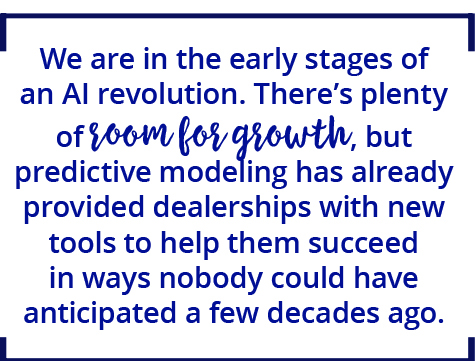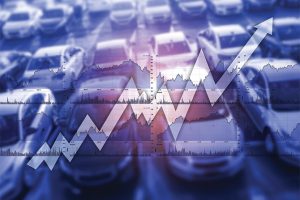By The West Virginia Automobile Dealers Association
The current U.S. economy is spectacularly unpredictable and is likely to continue that way for a while. But you can still sell successfully. You are just going to have to be more strategic about it. Now is the time to combine your marketing skills with marketing data. Where do you start?
Start by continuing to use marketing campaigns. People like to buy products they are familiar with from companies they trust. You don’t want to wait to build a relationship with a potential buyer if you can start that relationship sooner, because if you wait, you may never make the sale at all.
Since so many people are now working from home and may never go back to commuting again, spend your marketing dollars on media that has the best chance of reaching people, such as social media and magazines or other direct mail. Until televised sports are being broadcast regularly again, you might want to pull back on television ads.
When considering television ads, you should be aware of the following:
- The best marketing always works to provide customers with the information they actively want. Just because it is possible to run an ad doesn’t mean you should. People avoid unwanted ads or (worse) are irritated by them. That is not a good marketing strategy.
- The COVID-19 shutdown caused media consumption to increase by almost 60%, but the big beneficiary was streaming video, not traditional programming. Streaming video increased (on average) 61%. For adults 18+, the time spent viewing live and time-shifted TV has fallen by 7% in the third quarter of 2019, while time spent watching shows on TV-connected devices went up 17% during the same period. Please note, the measurement was taken before the shutdown.
- Approximately 91% of all people in the U.S. subscribe to a streaming service. For viewers aged 18-34, the percentage is 96%. Some 30% of all viewers have three or more video streaming services.
- The conventional advertising model has calls to action that require viewers to go to a store to spend their money. That approach is now as outdated as a stadium full of cheering fans. Many people have concerns about social distancing, and they are often uncomfortable in their masks even when they make a point of wearing them. Make it as easy as possible for people to buy online instead of in-person, and ask people to visit your website instead of your store.
Marketing costs money, but do what you can to spend marketing money wisely. Then you don’t have to spend as much. The average marketing cost per sale, according to NADA, is $624. Using the right technology can bring that average down. For example, the standard for dealers who use automotiveMastermind’s MarketEyeQ is $115.
Why does technology make a difference? It enables you to use your resources more effectively by focusing on what you have in stock and using prediction modeling to increase retention sales. It also helps you see major buying trends. Half of the buyers are currently moving to new dealerships and new brands when they buy. Even if you lose some of your existing customers, you can still increase your customer base if you can convince new customers to buy from you.
The data provided by technology can help you sell cars in three ways:
- Combine data from major market players such as Carfax, IHS Markit and TransUnion to help you see industry trends and identify high-quality leads.
- Determine when prospects are most likely to buy a vehicle by applying predictive modeling.
- Develop personalized sales scripts. Scripts are another way to apply predictive modeling because the modeling can tell you why potential customers are interested in buying a vehicle.
The driving force is the data, and more particularly, the predictive modeling that results from analyzing that data.

What should you know about predictive modeling?
- It has multiple names that include predictive analysis, predictive analytics and machine learning. Of the four terms, the one that has been most popular on Google since 2004 is machine learning. Excluding machine learning, the general and most commonly used name is predictive modeling.
- Commercial applications often use the term predictive analytics, but academic settings also favor predictive analytics.
- Machine learning is technically considered to be different from predictive modeling because it relies on statistical techniques so computers can build predictive models. In practice, the two terms are often used interchangeably.
- Machine learning is part of the development of artificial intelligence.
The valuable thing about predictive modeling is that it can challenge key assumptions. People see what they expect to see, and sometimes they are blind to what the data tells them. Being able to consider future events and evaluate outcomes is as helpful as it is difficult. Still, predictive modeling can increase accuracy and help a dealership maintain a competitive advantage because of those unexpected insights.
Is predictive modeling perfect? No. It tells you likely outcomes, but sometimes the outcomes are anything but likely. Experts thought it might be time for a recession before the Shutdown Recession, but they didn’t expect it to result from a pandemic, and no one expected the severity. Election outcomes are also difficult or impossible to spot in advance; Nate Silver has been on both sides of that difficulty. But even an imperfect assessment can put you ahead of other dealers, and the quality of those assessments will improve over time.
The data used to feed predictive models comes from a variety of sources:
- Customer Relationship Management (CRM)
- Customer service
- Demographic information
- Digital marketing and advertising
- Economic information
- Geographical information
- Machine-generated data from telemetry or sensors
- Surveys and polls
- Transactions
- Web traffic
Of course, the trick is not just modeling data; it is modeling data into relevant information for your specific strategic business goals. Equally important is evaluating the accuracy of a model in hindsight. You don’t know how successful something is until you measure that success. Those measurements can then help you to improve the system and get better results with the next model. Pay attention to how the model includes the following areas:
- Benchmark analysis
- Data gathering and cleansing
- Goal evaluations and key performance indicators (KPIs)
- Action plan development
- Plan execution
- Process improvement
When using data to sell cars, remember that the process is part of the same process that will someday bring us autonomous vehicles. We are in the early stages of an AI revolution. There’s plenty of room for growth, but predictive modeling has already provided dealerships with new tools to help them succeed in ways nobody could have anticipated a few decades ago.
The West Virginia Automobile Dealers Association
This story appears in the 2019-2020 Issue 4 of the WVADA Magazine.









